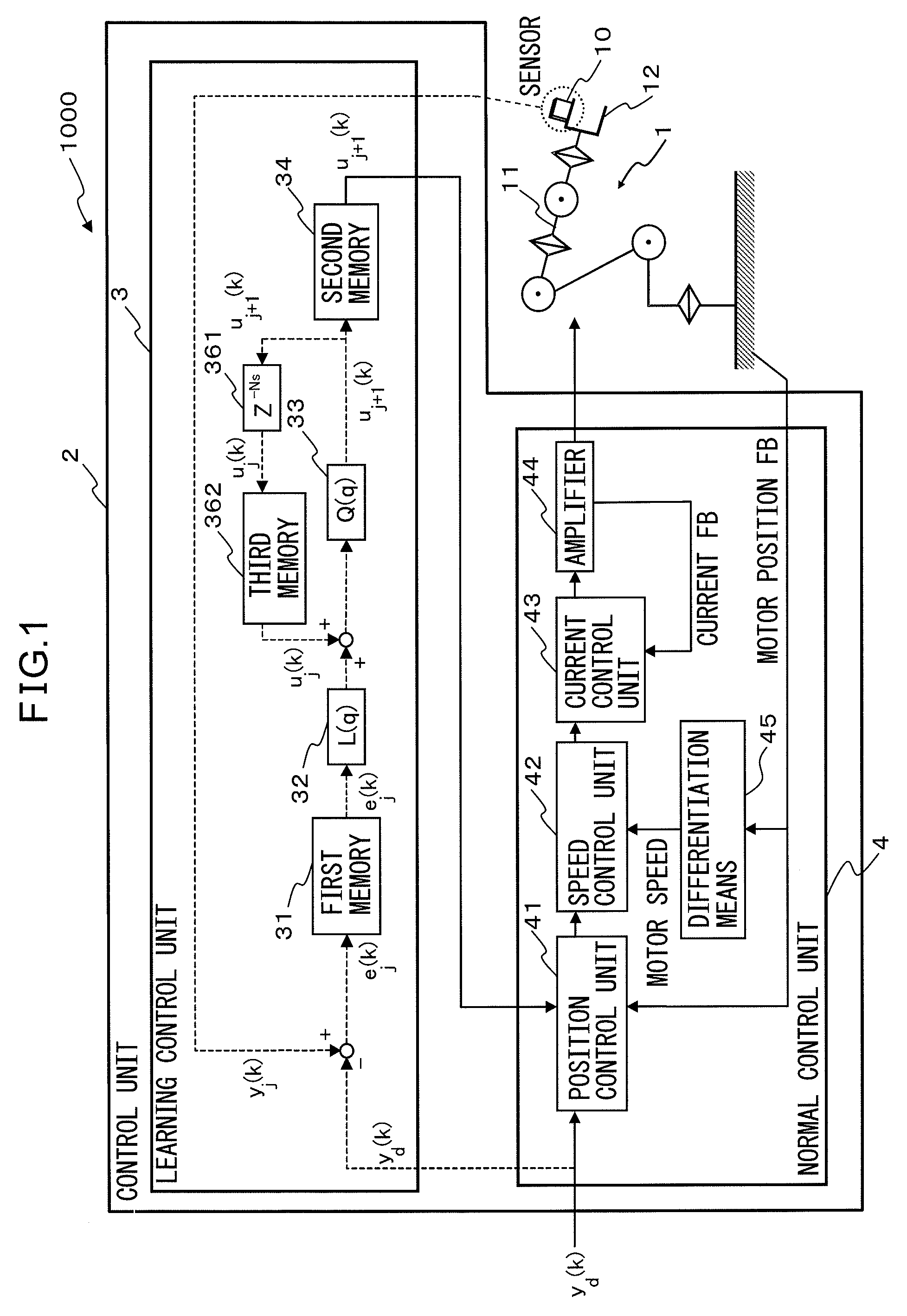Robot and spot welding robot with learning control function
a robot and function technology, applied in the field of robot and spot welding robots having learning control functions, can solve the problems of narrow application range, inability to measure the trajectory error and position vibration component of the arm, and inability to produce position vibration components, etc., to improve the accuracy and safety of operation of the robot mechanism unit, reduce system cost, and increase the speed of operation during learning
- Summary
- Abstract
- Description
- Claims
- Application Information
AI Technical Summary
Benefits of technology
Problems solved by technology
Method used
Image
Examples
first embodiment
[0077]FIG. 2 is a schematic diagram of a robot 100 according to the first embodiment. The robot 100 is configured with a robot mechanism unit 1, and a control unit 2 that controls the robot mechanism unit 1. The control unit 2 has a learning control unit that executes learning control for the robot 100, and a normal control unit 4 that controls the operation of the robot mechanism unit 1 by driving the robot mechanism unit 1 directly.
[0078]The learning control unit 3 operates the robot mechanism unit according to a speed command which is given by multiplying the teaching speed designated in a task program by a speed change ratio. From a detection result of an acceleration sensor 10, the learning control unit 3 executes learning for calculating a learning correction amount uj+1(k) for making the trajectory or position of the control target of the robot mechanism unit 1 approach closer to the target trajectory or target position that is assigned to the normal control unit 4. Otherwise...
second embodiment
[0184]Next, a robot according to a second embodiment will be described. FIG. 11 shows a schematic view of the robot according to the second embodiment. In addition to the robot 100 according to the first embodiment, a robot 101 according to the second embodiment has a feature of further having a teaching control unit 50 which includes a program teaching unit 51 that stores a task program, a program executing unit 52, and an operation planning unit 53. The teaching control unit 50 teaches or corrects the position or speed in a task program.
[0185]Also, the normal control unit 4 of the robot 101 according to the second embodiment further has an anti-exception processing unit 46. This anti-exception processing unit 46 operates the robot mechanism unit 1 according to a position command based on a teaching position that is set in a task program, a learning correction amount uj+1(k) that is calculated in the learning control unit 3, and a speed command that is given by multiplying a teachi...
third embodiment
[0197]With the present embodiment, an example to increase speed of the operation of a spot welding robot will be described. First, FIG. 14 shows a perspective view of a robot mechanism unit of the spot welding robot. Also, FIG. 3 shows a configuration of the robot mechanism unit of the spot welding robot. FIG. 3A shows an overall configuration of the robot mechanism unit, and FIG. 3B shows an enlarged view of a spot welding gun (hereinafter referred to as simply “gun”) on which a sensor is mounted. The robot mechanism unit 1 is a well-known robot manipulator and has no limitations regarding its mechanism as long as the gun 12, which is the control target part and is subject to position control, can reach the positions and postures to perform tasks. The gun 12 has a pair of electrodes (namely, a counter electrode 21 and a movable electrode 22), and, by making the interval between the counter electrode 21 and the movable electrode 22 variable by making one of them movable, is able to ...
PUM
| Property | Measurement | Unit |
|---|---|---|
| frequency | aaaaa | aaaaa |
| frequency | aaaaa | aaaaa |
| speed | aaaaa | aaaaa |
Abstract
Description
Claims
Application Information
 Login to View More
Login to View More - R&D
- Intellectual Property
- Life Sciences
- Materials
- Tech Scout
- Unparalleled Data Quality
- Higher Quality Content
- 60% Fewer Hallucinations
Browse by: Latest US Patents, China's latest patents, Technical Efficacy Thesaurus, Application Domain, Technology Topic, Popular Technical Reports.
© 2025 PatSnap. All rights reserved.Legal|Privacy policy|Modern Slavery Act Transparency Statement|Sitemap|About US| Contact US: help@patsnap.com



